Matchday 33 saw the Bundesliga enter its penultimate round of fixtures, with many teams at the top battling it out to cement their position in the European places. Bayer Leverkusen was one of these teams entering this match week looking to add another three points to their tally to confirm their position in the top four.
Bayer Leverkusen were entering this away game against Hertha Berlin after a great win at home in midweek against FC Köln. Another win for them today would almost certainly confirm their position in next seasons UEFA Champions League campaign. Hertha Berlin had seen their season revitalised under new boss Labbadia, having conceded only two goals in his first four games in charge. However, with three losses on the bounce in their last three games, Hertha were entering this game looking to turn this poor run of form around.
This tactical analysis will examine the tactics used by Hertha Berlin which saw them win 2-0. Their domination of the half-spaces in advanced areas when attacking, as well as their effective organisation out of possession as units, will be depicted as main reasons why they were able to take all three points. Additionally, Bayer Leverkusen’s lack of support for the player with the ball will also be analysed as a main factor that contributed to them failing to create any real threat going forwards.
Lineups
For Hertha Belin’s last home game of the season, Labbadia set them out in his favoured 4-2-3-1 formation. First choice keeper, Rune Jarstein, started in goal, with a back four made up of Marvin Plattenhardt, Jordan Torunarigha, Dedryck Boyata and Peter Pekarík. Hertha’s double pivot players were Marko Grujic and Niklas Stark. Rising star Matheus Cunha occupied the left attacking midfielder’s role, whilst Dodi Lukébakio occupied the right and Vladimír Darida started in the centre. Krzysztof Piatek led the line for the home side.
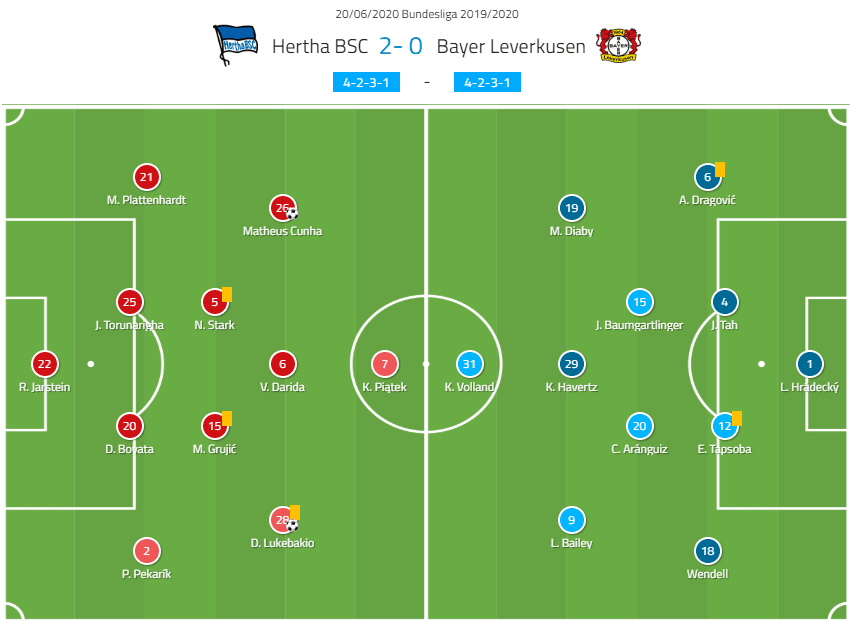
Leverkusen travelled to Berlin for their last away game of the season and Peter Bosz set up his side in a 4-2-3-1 formation. First choice and veteran, Lukás Hrádecky, started in goal, with Aleksandar Dragović, Jonathan Tah, Edmond Tapsoba and Wendell making up the back four. Leverkusen’s double pivot players were Julian Baumgartlinger and Charles Aránguiz. Their front three attacking midfielders were Leon Bailey, Kai Havertz and Moussa Diaby, whilst Kevin Volland was the lone striker.
Hertha Berlin’s effective use of the half-spaces
In the four games leading up the to match against Leverkusen, Hertha had lost three and only scored four goals, conceding seven. Going into the penultimate game and trying to finish as high in the table as possible, these were the issues that Labbadia needed to address. During the game against Leverkusen, Hertha were dominant and effective going forwards with the ball and their use of the half-spaces enabled them not only to enter the Leverkusen box but also create goal-scoring opportunities. Hertha are currently expected to score 1.42 goals per 90 and their effective use of the half-spaces enabled them to perform way over this rating.
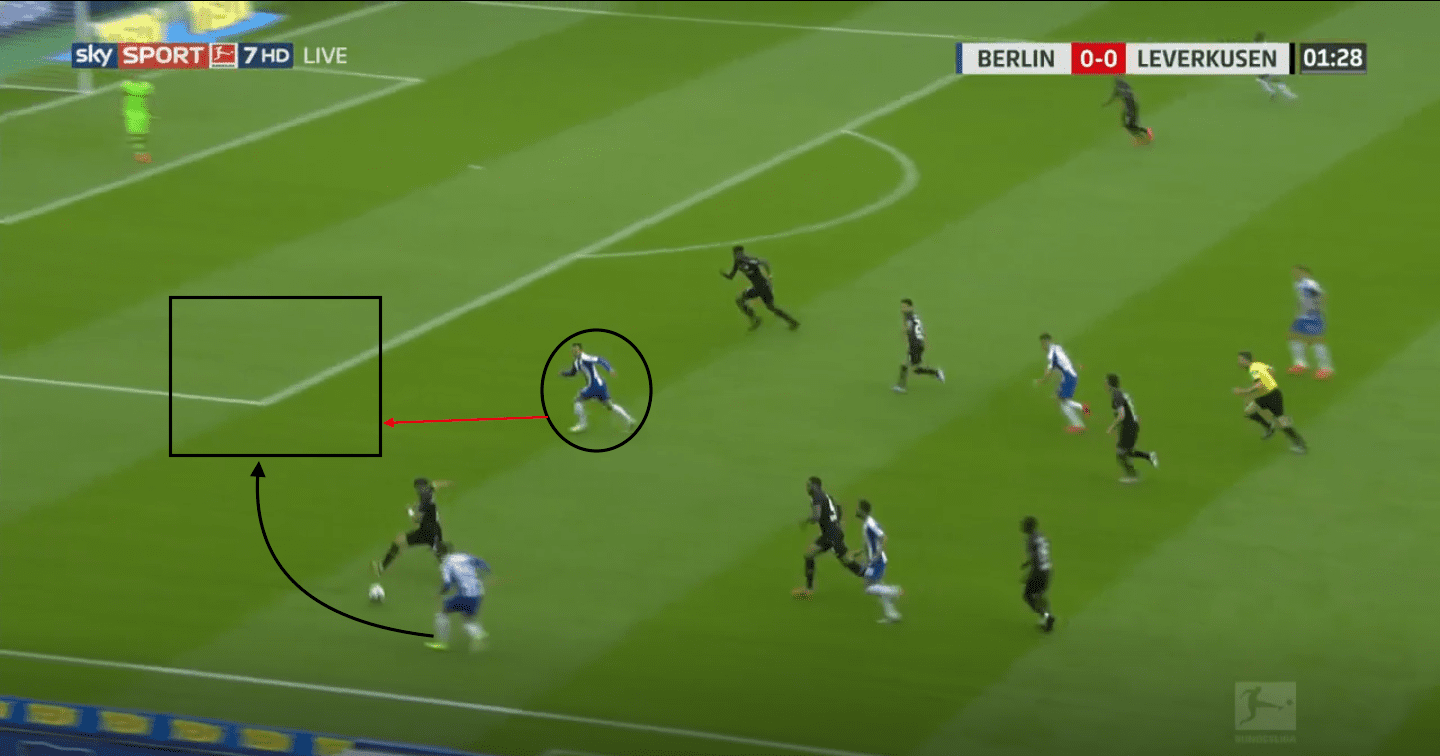
Alongside progressing the ball into the wide areas when in possession, Hertha’s dominance going forward is also seen by them exploiting the half-spaces and overloading these areas on both the right and left-hand sides. In this above example in the first few minutes of the game, Darida moves out of his central attacking position to place himself in the left half-space which creates a 2v1 overload scenario against the Leverkusen right-back Dragović. Plattenhardt, on the ball, can play a pass into the half-space in behind, which then gives Hertha a 1v1 situation on the edge of the Leverkusen box. Within the first few minutes, Hertha’s effective use of these areas was clear to see.
Although Hertha only had 36% possession throughout the whole game, their strategy to progress the ball when in the attacking half was highly effective. Although it could be argued that Leverkusen’s defensive unit was massively unorganised during many spells in the game, Hertha’s timing of the run into the half-spaces and timing of the pass to exploit these areas enabled them to gain the most success.
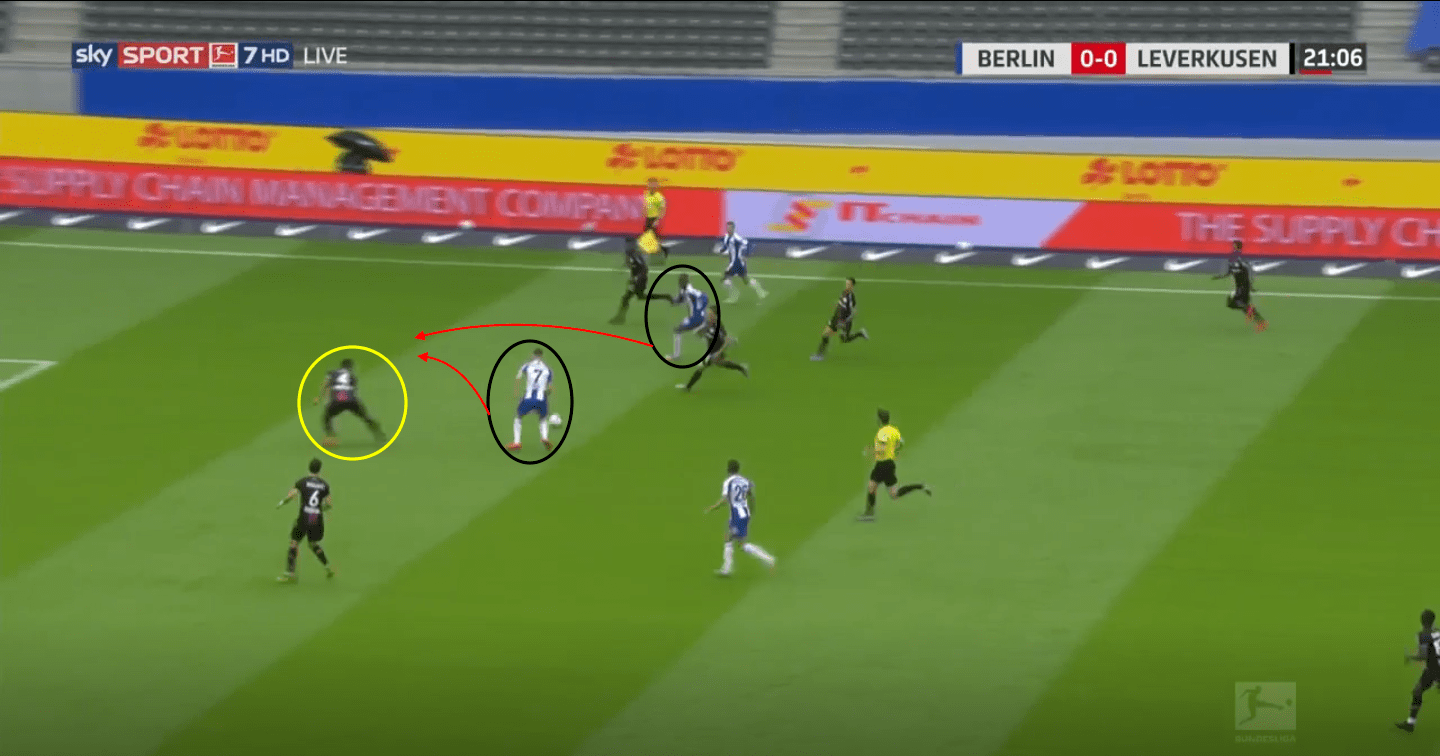
In the build-up that led to the Cunha goal and Hertha’s first, they used the right half-space to progress the ball into the Leverkusen penalty area. Lukébakio received a ball on the wide right-hand side from the central area. Upon receiving, he took his first and second touch into the right half-space. As Lukébakio was performing this action, Piatek made a run towards the right half-space to receive from Lukébakio. Piatek’s run forced Tah to follow, meaning there was again a 2v1 overload situation in the right half-space.
It is very important to note that Hertha don’t just dominate one half-space. They have the ability to dominate and effectively use both half-spaces. If one side half space passing or running line is blocked, the player with the ball will switch the point of attack to the opposite half-space as we see in the below example.
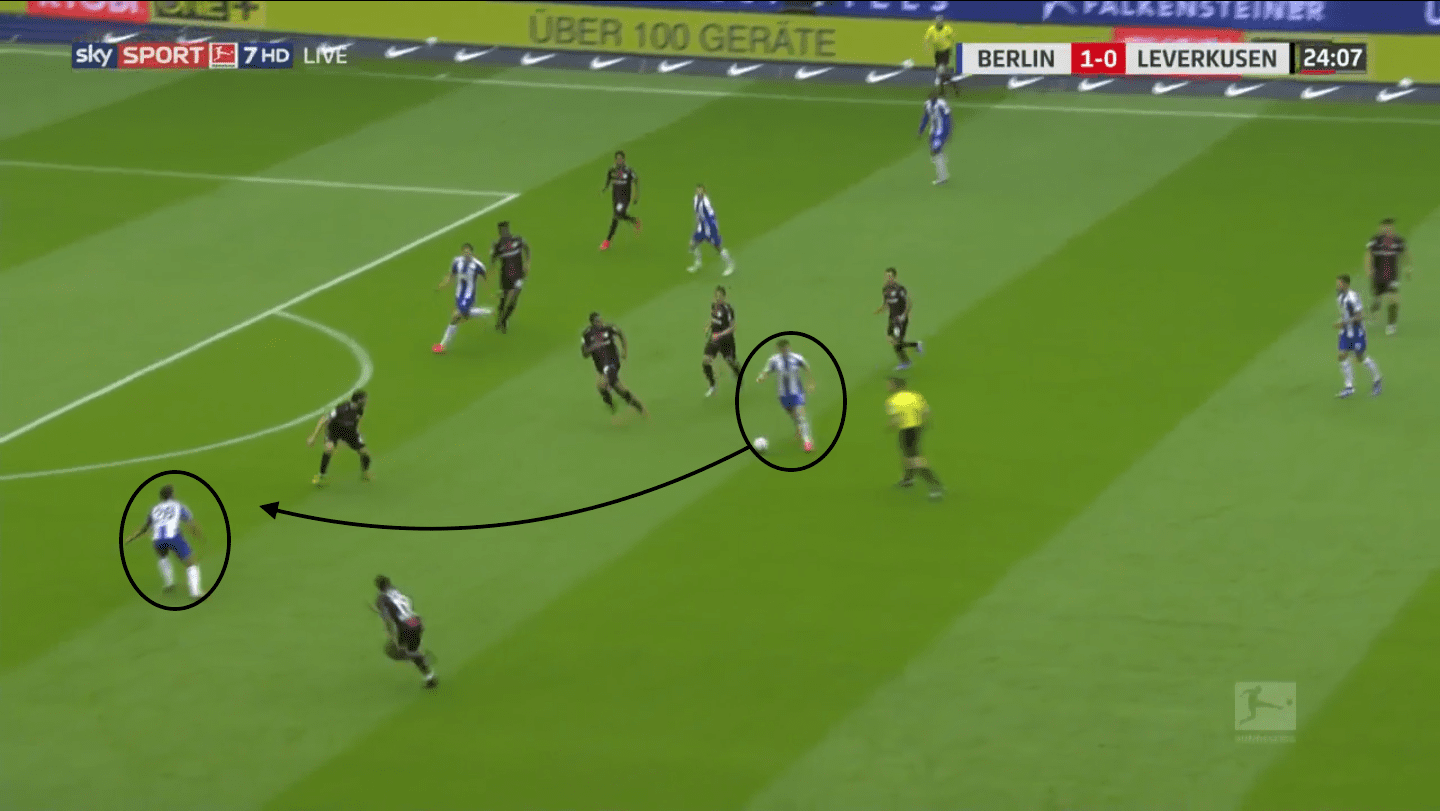
Searching for their second, Piatek has the ball in the central space. Having tried to progress the ball through the right half-space, he saw passing lines blocked which forced him to find alternative routes into the box. Whilst this motion was taking place, Cunha held his position in the left half-space which provided a clear passing line for Piatek to progress the ball into the penalty area.
The movement of Piatek to try and progress the ball through the right half-space forced Leverkusen’s defensive line to become very narrow and out of position. Cunha’s timing of the run and holding his position in the left half-space allowed Hertha with an opportunity to score. Although they failed to score from this opportunity, the effective use of the half-spaces was apparent even more as the game progressed.
Throughout this game, Hertha made 45 passes into the final third and 15 passes into the penalty area. Despite these numbers being heavily lower than Leverkusen’s, Hertha had less possession of the ball but used the attacking areas more effectively than Leverkusen.
It is also important to comment that Hertha don’t just use the same player for both half-spaces. Their rotations and horizontal runs in the half-spaces make it so difficult for the opposing team to defend against and track the runs.
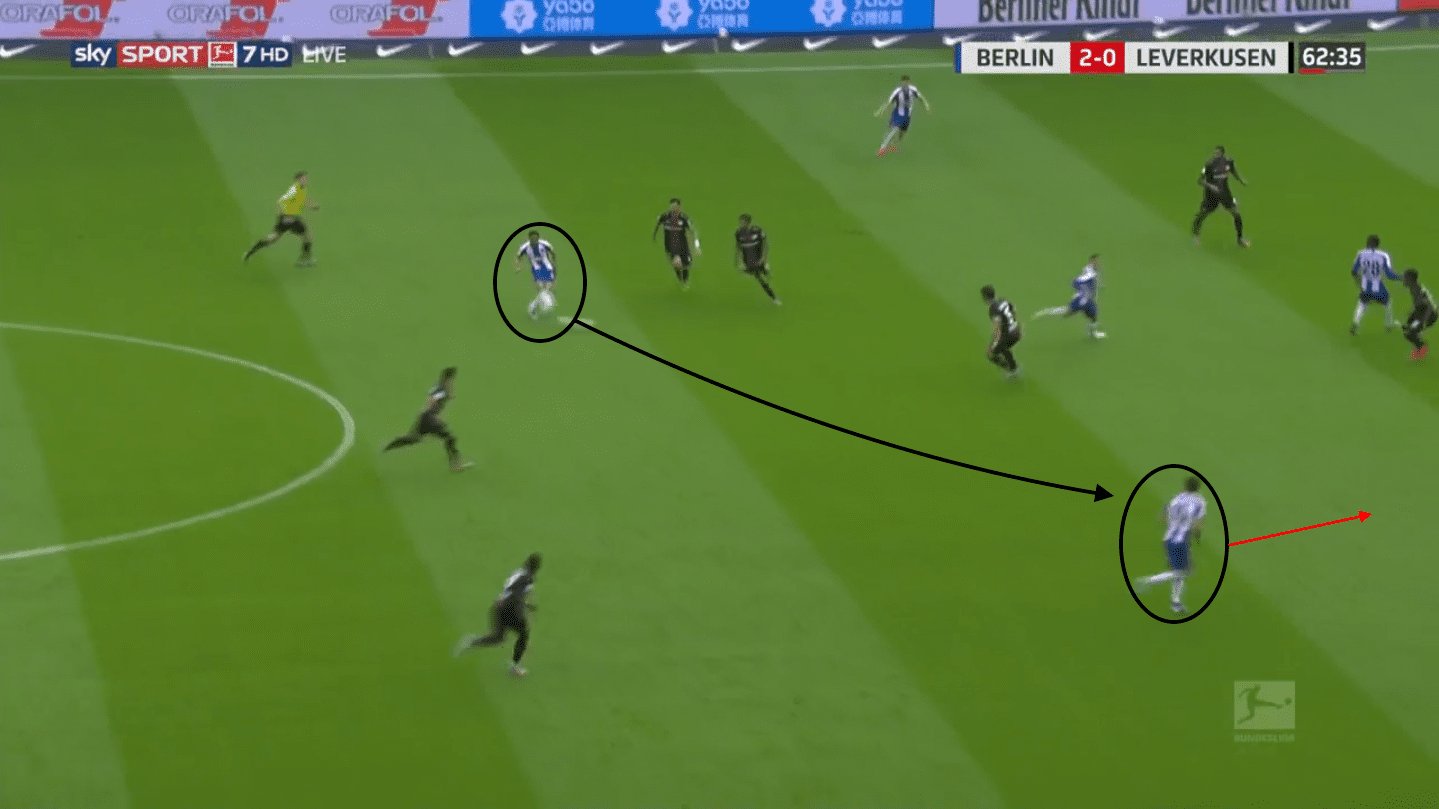
Hertha like to give the freedom to their right and left attacking midfield players in the half-spaces. However, if these players move into the central space when in possession, other players will make horizontal movements into these half-spaces to always provide the player with the ball an option to progress.
In this example, Cunha has the ball in the central area and instead of playing a backwards pass, he looks to switch the play to the right side. Grujic has made a forward run from deep as he noticed the right half-space wasn’t occupied due to Lukébakio’s movement in field. Although we commonly see the likes of Cunha and Lukébakio in the half-spaces, player rotations and recognition by other players to exploit the half-spaces if they aren’t occupied is another trait Labbadia has brought to the side.
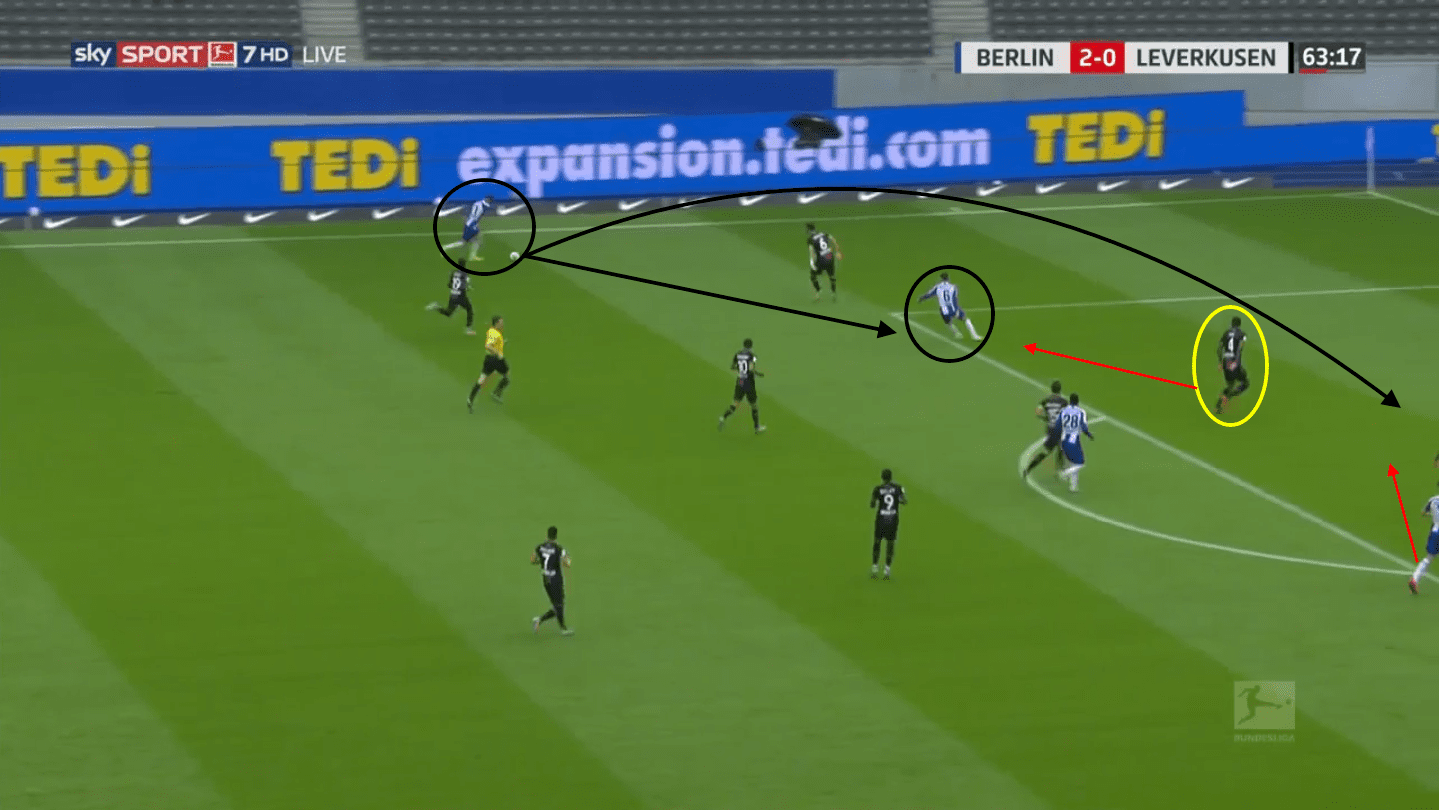
When a Hertha player enters the half-space but doesn’t receive, they can still affect how the effective the attack is. In the above image, Darida has entered the left half-space, which draws Leverkusen’s central defender Tah with him. This movement creates space in the centre for Piatek and Lukébakio to enter to successfully receive from a crossing action. This season, Hertha have produced 70 crosses into the penalty area, of which, nine were in this game. Of the 111 times Hertha had possession in the game, only 8% of the possession periods reached the penalty area. Despite this statistic being very low, the effective use of these times is what makes Hertha so successful in the attacking areas.
Leverkusen’s lack of movement off the ball
One of the main reasons why Leverkusen failed to take all three points from this game and confirm their place in the UEFA Champions League places was due to the lack of support players off the ball provided. Leverkusen have an xG per 90 rating of 1.82 and have scored 60 goals this season. During the game against Hertha Berlin, they averaged 64% possession but failed to capitalise on their long periods with the ball. This analysis will depict why this was their main issue and offer solutions as to where players could have moved off the ball to create options to receive.
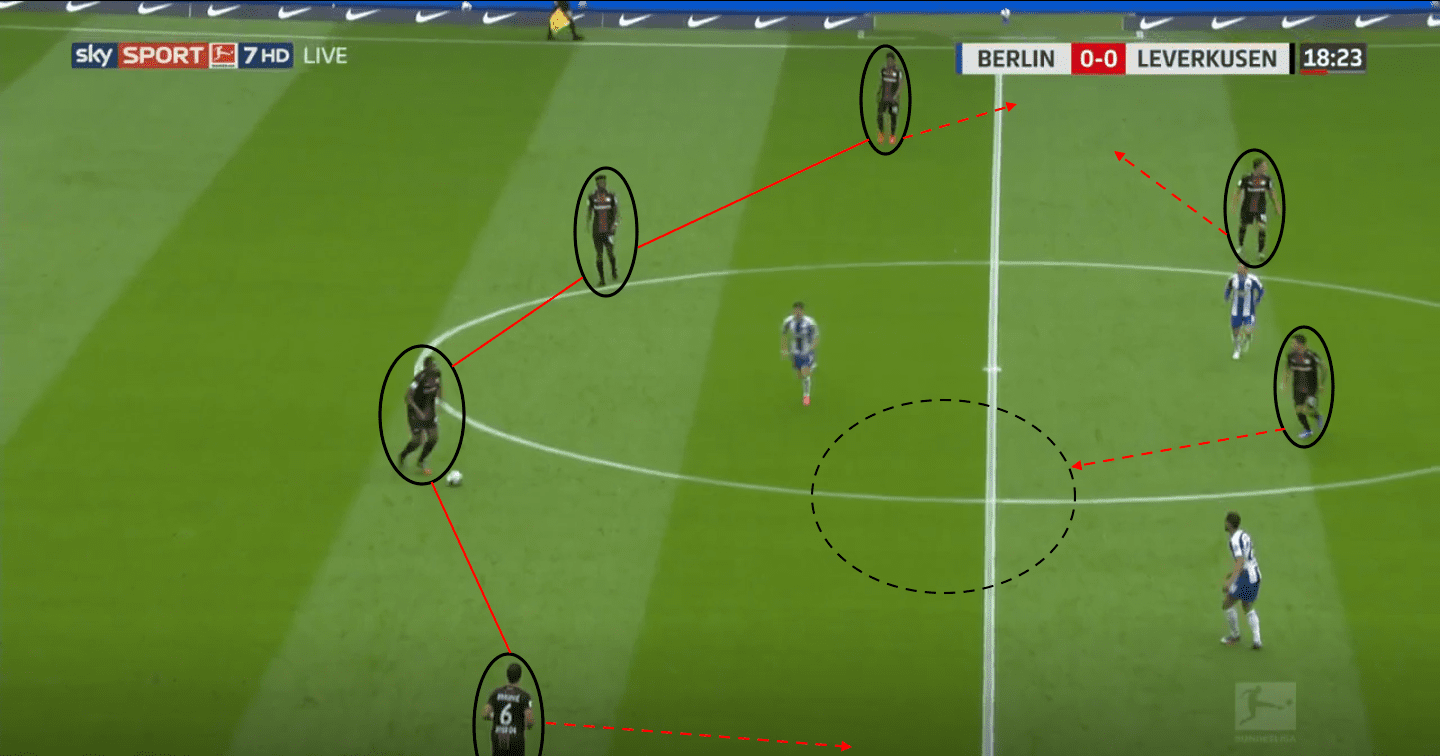
Leverkusen’s main downfall during their loss away at Hertha was their lack of movement off the ball and their failure to support the player on the ball with forward passing options. In this scenario, Tah has the ball and is looking for an avenue to progress the ball forwards. As Leverkusen fielded with two double pivots, none of them dropped deep to provide a passing option. As we see above, Tah doesn’t have any options apart from playing a lateral pass to Dragović. As Dragović receives, he is pressured by Cunha and doesn’t have any forward options, so reverts to playing a backwards pass.
Firstly, Tah would have had more passing options to progress if Leverkusen’s two full-backs were higher and providing more width. This would have stretched the Hertha press and created space in behind for players to receive. Secondly, either of their pivot players Aránguiz and Baumgartlinger could have dropped into the space to receive to draw one of Hertha’s attacking midfielders out of position, leaving space in between the lines for a Leverkusen attacking player to receive.
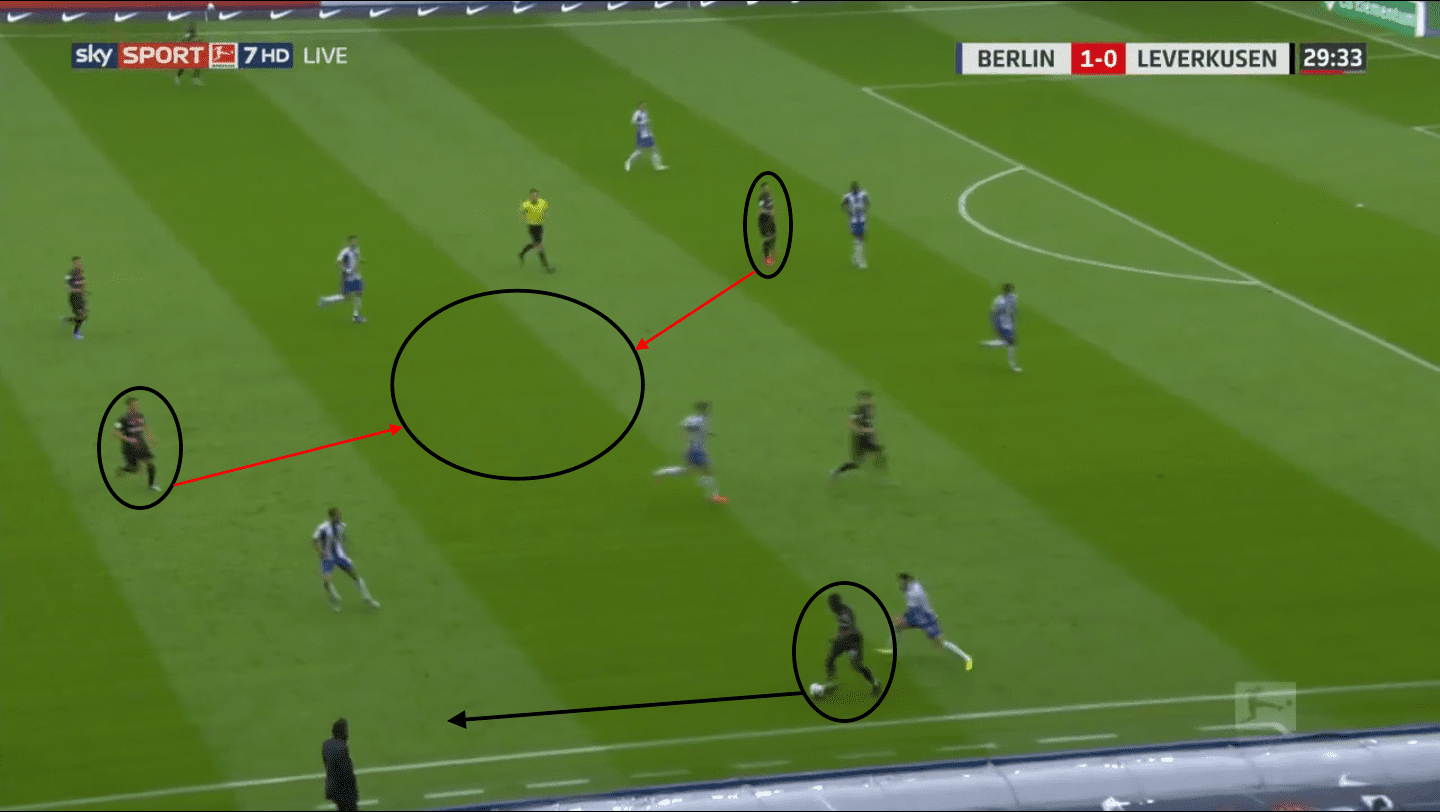
One of Peter Bosz’s main styles of play is to heavily dominate and overload the central areas when his team are in possession. It is a strong argument to make that Hertha’s defensive unit organisation meant Leverkusen were unable to effectively use these areas, and instead forced them to the wide areas where they failed to create any real threats going forwards.
In the above image, Diaby has the ball in the wide right area and has to turn back to make a backwards pass due to lack of movement in advanced areas. If Baumgartlinger or Volland had ventured into the central space to receive, then this could have provided Diaby with more passing options to progress the ball forwards.
Although Leverkusen dominated possession and had an average possession duration of 16 seconds, only 33% of their passes into the penalty area were successful. When progressing the ball, only 23% of their through passes were successful and of 16 crosses, only 13% were accurate. If players off the ball made movements into space then not only would there have been more passing options, the success and chance creation would have been much higher.
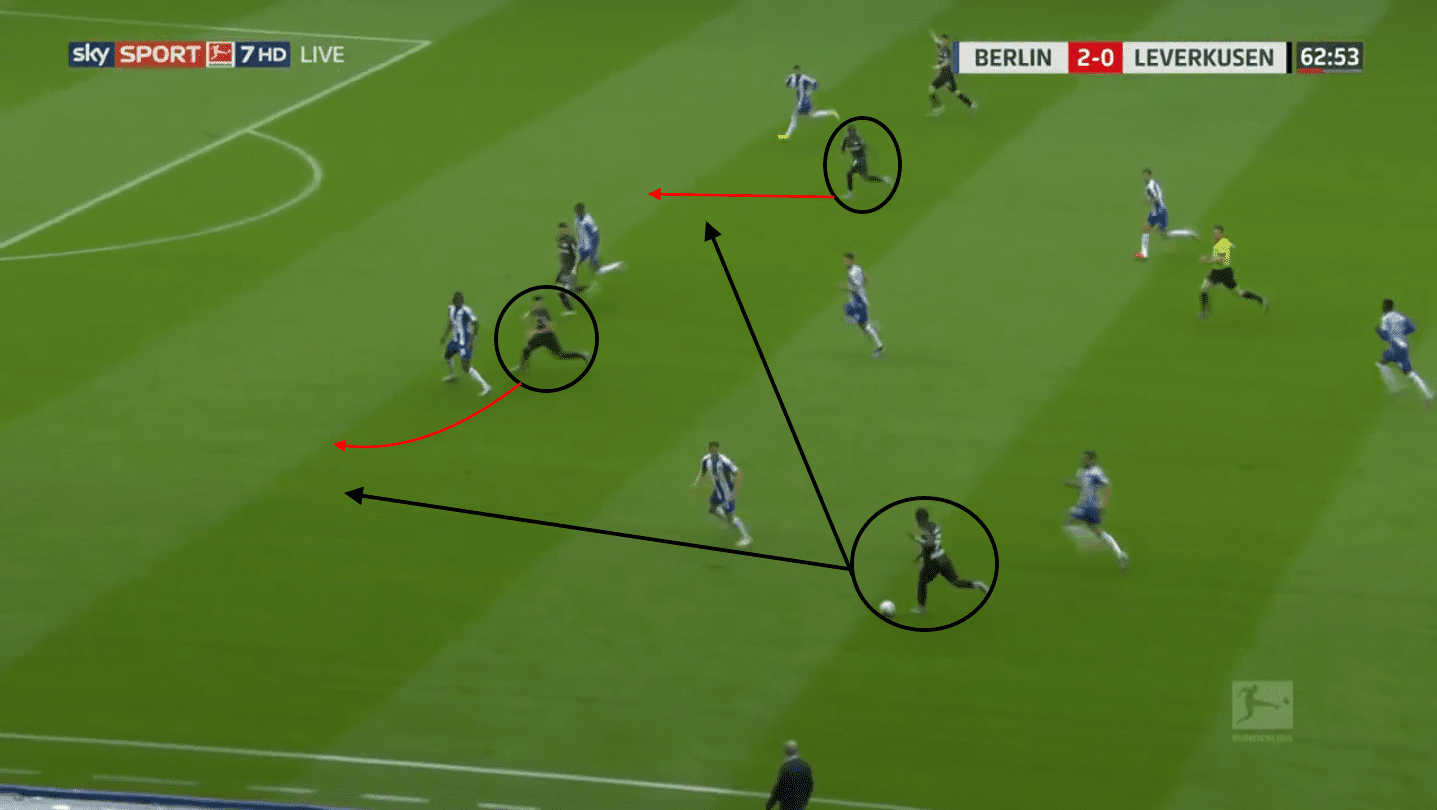
As Wendell looks to carry the ball forwards, his passing lanes to Volland and Diaby are blocked by Hertha’s defensive organisation. Leverkusen’s forward players failed to time their run to provide Wendell with forward passing options. If Diaby had a made a quicker forward run to exploit the space in between the Hertha backline then Wendell would have had a clear passing line to him. In addition, the attacking players were too close together instead of exploiting and isolating the half spaces to enter into the Hertha penalty area.
As this analysis has previously stated, Boszs’ teams like to use the central areas to progress the ball. In this game, Leverkusen tried to use the central areas but failed to provide any support to dominate these areas when going forwards. They made a total of 55 attacks in the game, but only 8% led to a shot attempt.
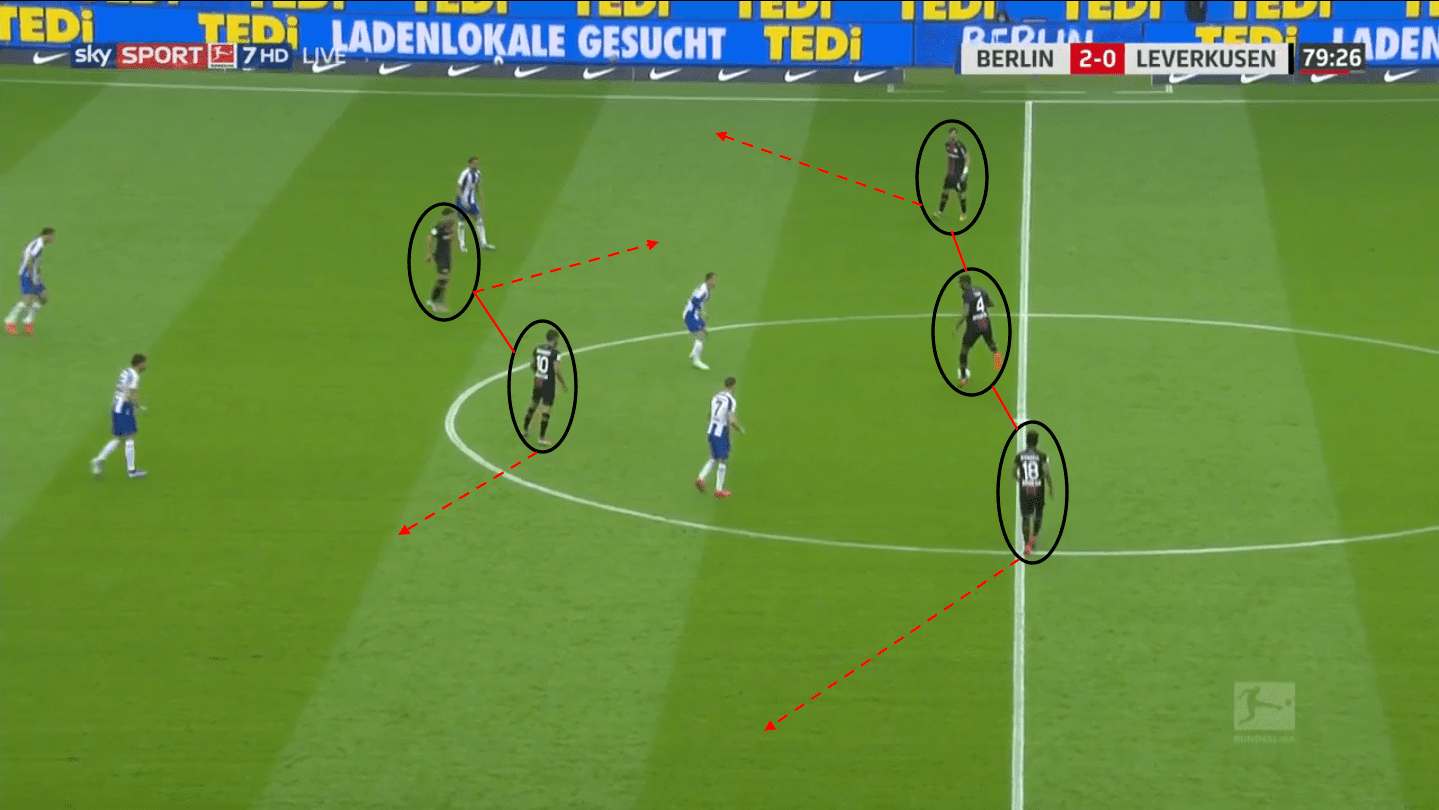
We again see Tah in possession on the halfway line but the lack of movement from his teammates off the ball allows Hertha to get organised and block the central area. Leverkusen’s two full-backs could have opted for a wider position in space to receive which could have enabled them to progress forwards quicker. In this scenario, their two pivot players are too narrow, meaning they are easy to mark. If they performed diagonal movements from one another into space then Tah would have had more options on the ball to play forwards.
Hertha’s out of possession unit organisation
As well as effectively using the half-spaces when in possession, Hertha were also very organised defensively when out of possession and compacted the central area to force Leverkusen to the wide areas. Under previous managers early in the season, Hertha were very poor as defensive units, leaving space for the opposition to exploit. Since Labbadia has been at the helm, Hertha have made it very difficult for other teams to break them down. Although Hertha, on average, allowed Leverkusen to make 15.0 PPDA, they blocked off and condensed the central area and central passing lines which meant Leverkusen posed no real threat when trying to advance forwards. Hertha also forced them to make more lateral passes (262) than forward passes (182).
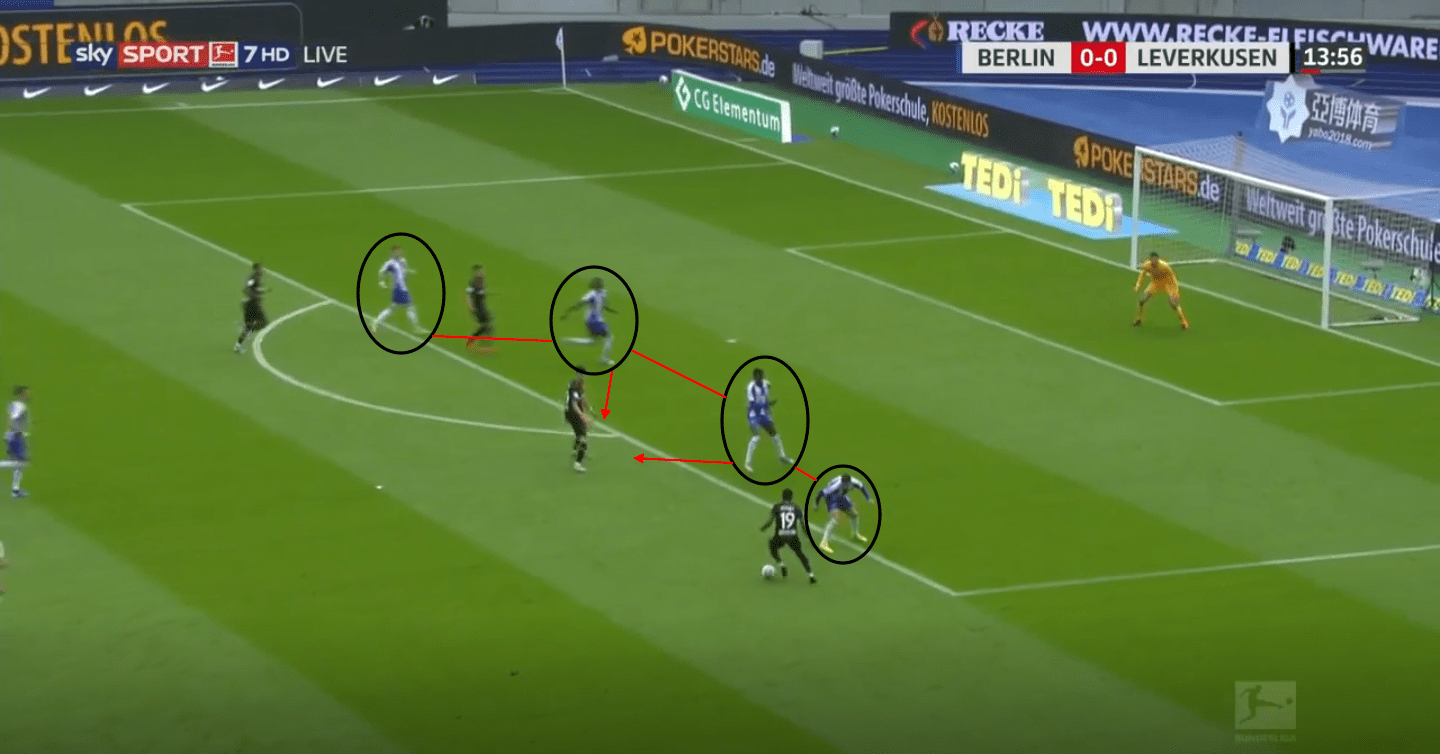
Across the whole of the pitch when out of possession, Hertha’s defending as units were very organised and made it very difficult for Leverkusen to create any real danger. In this first example, Hertha’s back four defensive shape is very organised, with Plattenhardt performing the correct side on body position and the first to press. Boyata and Torunarigha provide the cover and balance. They are also very narrow which prevents space and split passes to be performed in dangerous areas.
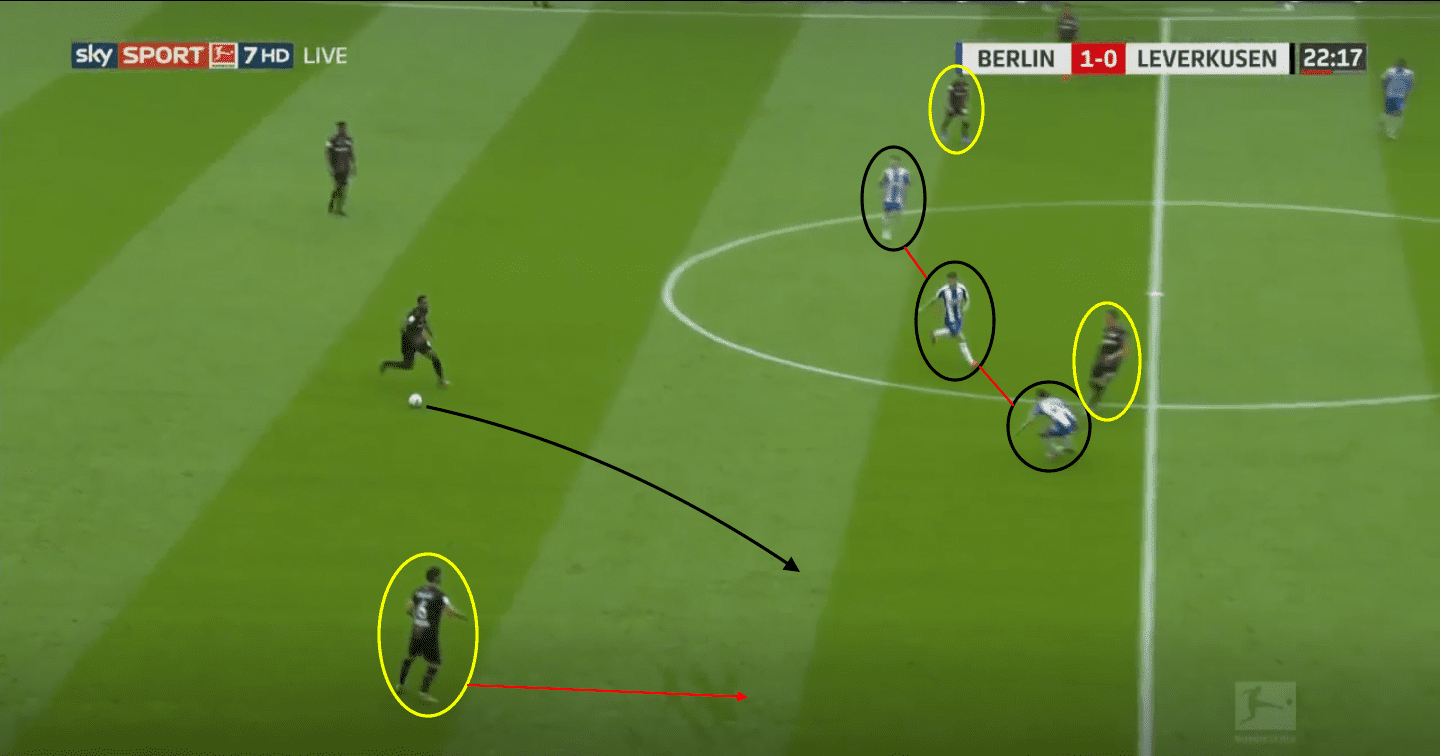
This analysis has mentioned on numerous occasions how Hertha’s main tactic was to prevent Leverkusen from progressing through the central areas. In the above example, we can see that Piatek, Cunha and Darida become very narrow to prevent a pass through the centre from being made. They force Tah to play to Dragović on the right who then has to play a backwards pass to the goalkeeper to find other routes to attack.
When Leverkusen were looking to play into their attacking players in the Hertha half, Berlin surrounded and compacted the pivot players to prevent the ball being played to them to start an attack. The below example is one time when Hertha prevented the pivot player from receiving.
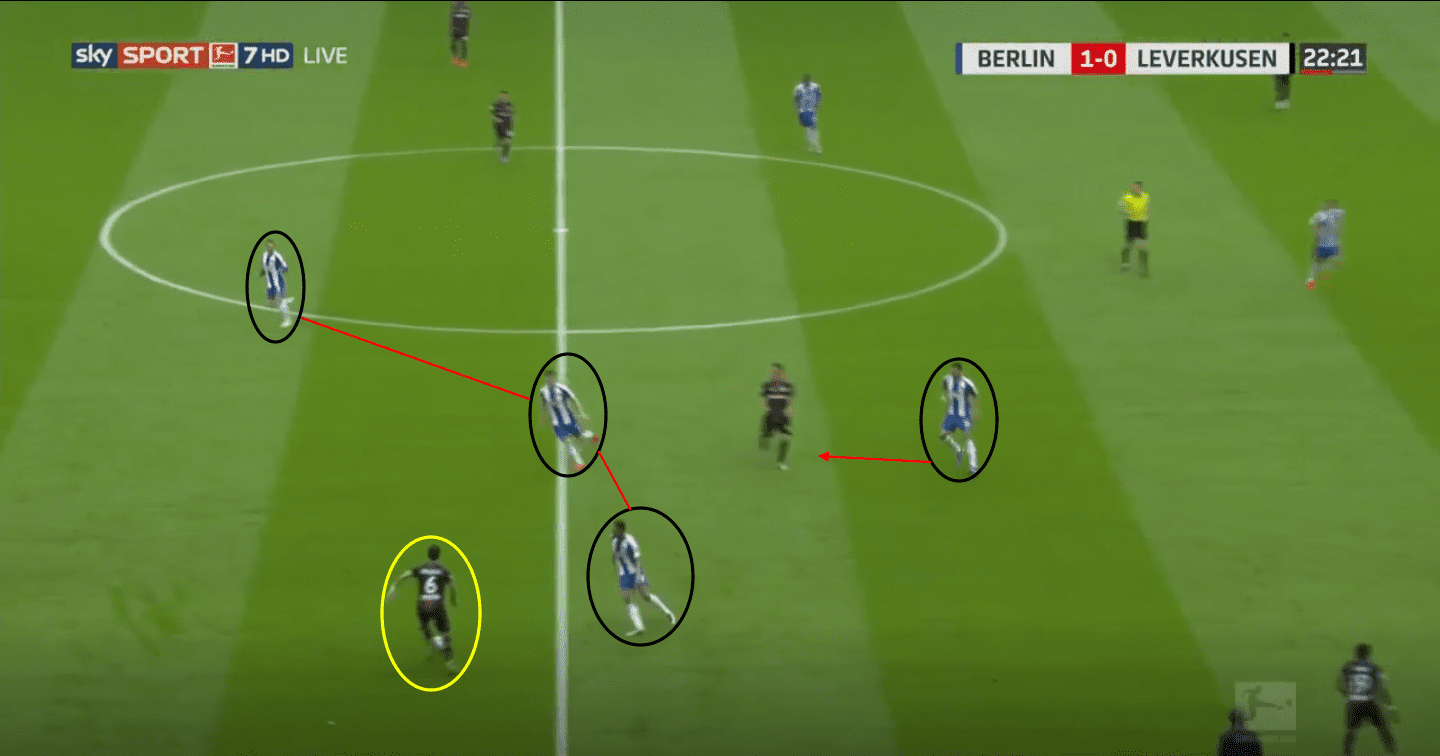
Cunha, Piatek, Darida and Grujic are all engaged in the defensive unit organisation, being very narrow to prevent split passes into the pivot players. Grujic has also pushed up out of his defensive position to prevent a through pass to be made. This forced Leverkusen back to the goalkeeper time after time.
In the second half, Hertha still prevented Leverkusen from progressing forwards through the use of their structured organisation as a unit when carrying out a press.
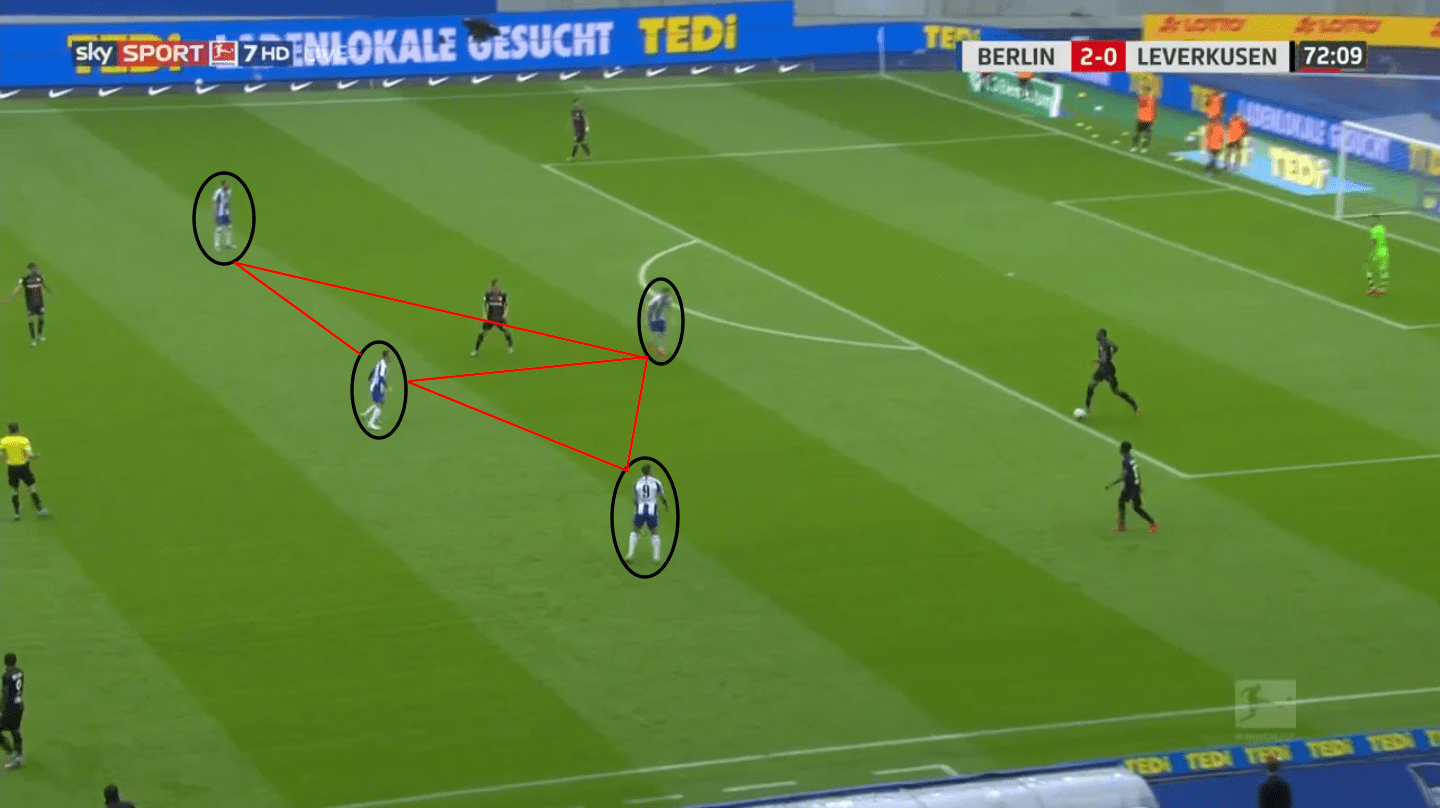
Tah once more has the ball deep in his own half and although Hertha do not perform a high press against him, their organised unit out of possession with their three attacking midfielders and Piatek preventing them from receiving between the lines or playing into their attacking players easily cased Leverkusen with real problems in their build-up. Even at 2-0 up Hertha still managed to keep their organisation to prevent Leverkusen from exploiting the space in between the lines.
Conclusion
In this tactical analysis, we have identified the tactics used by both teams to try and keep their momentum going into the last game of the season. Hertha Berlin were very effective when they had the ball, using the half-spaces effectively to create goal-scoring opportunities and to advance into the penalty area. Hertha were also very organised as a team when out of possession, forcing Leverkusen to the wide areas where they failed to create any real danger.
Leverkusen, on the other hand, were very poor in possession and lacked any real quality. Their movement off the ball to support was slow and lacked any real quality in the attacking half. Having already played the big sides such as Bayern Munich, they go into their last game against Mainz 05 looking to creep back into the UEFA Champions League places.





Comments